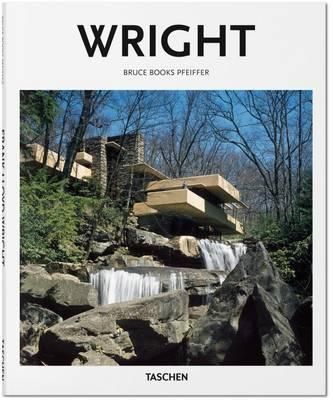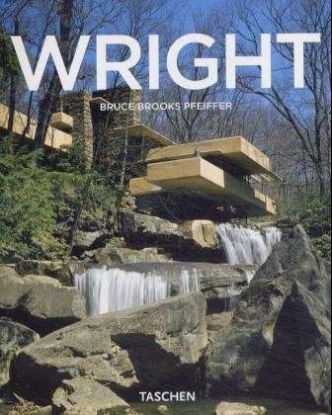Pfeiffer Brooks
autor
Wright
Najväčší syntetik architektúry všetkých čias Frank Lloyd Wright realizoval počas svojej kariéry takmer všetky typologické druhy. Kniha, ktorá ho predstavuje ako umelca, ale aj ako človeka túžiaceho po slobode, približuje jeho dielo a myšlienky všetkým, koho tvorba a osud tohto významného umelca zaujíma. Wrightove budovy zmenili tvár svetovej architektúry. Vývin jeho diela od „ prérijných domov“ až po organickú architektúru je dôkazom nesmiernej tvorivosti jeho ducha, ktorú však vždy sprevádzala pevná viera v platnosť a dodržiavanie pravidiel. Medzi jeho dnes už legendárne stavby patrí Guggenheimovo múzeum v New Yorku, administratívna budova Larkinovej spoločnosti v Buffale či Johnson Research Tower v Racine vo Wisconsine. Zaujímavý je aj jeho vlastný dom a ateliér Taliesin West v Sonorskej púšti v Arizone.
Vypredané
8,48 €
8,93 €
Wright Complete Works Vol.1
Frank Lloyd Wright (1867-1959) is widely considered to be the greatest American architect of all time; indeed, his work virtually ushered in the modern era and remains highly influential today. His wide-ranging and paradigm-shifting oeuvre is the sub
ject of TASCHEN's three-volume monograph that covers all of his designs (numbering approximately 1100), both realized and unrealized. Made in cooperation with the Frank Lloyd Wright Archives in Taliesin, Arizona, this collection leaves no stone untur
ned in examining and paying tribute to Wright's life and work. From his early Prairie Houses (typified by the Robie House) to the Usonian concept home and progressive living architecture buildings to late projects like the spiral Guggenheim Museum in
New York and the development of his fantastic vision of a better tomorrow via his concept of the living city, all of the phases of Wright's career are painstakingly described and illustrated herein. Author and preeminent Wright expert Bruce Brooks P
feiffer highlights the latest research and gives fresh insight into the work, providing new dating for many of the plans and houses. A plethora of personal photos gives readers a feeling of what it was like to work in Frank Lloyd Wright's fellowship,
traveling each spring from Taliesin West to the old Taliesin complex in Wisconsin and returning the next fall to spend the winter in sunny Arizona again. This volume, Volume 1, covers the early Chicago years and the Prairie Houses, the period which
provoked a profound influence on European architects. Wright's architectural work during these early years was mostly residential, as it would be throughout his career, and from his earliest work, Frank Lloyd Wright demonstrated a knowledge of and re
spect for natural materials. In the ten years betweeen 1896 and 1906 he developed and perfected the so-called prairie house. Wright believed the architect should have complete charge of architectural design, and for him this meant interior furnishing
s as well as exterior landscape. He was not often given this freedom, but the 1908 Avery Coonley residence in Riverside, Illinois is one of the finest examples. With the administration building for the Larkin Soap Company (19031905) and the Unity Te
mple (1905) he could realize bigger commissions. In 1910 he worked on his famous publication Ausgeführte Bauten und Entwürfe for the German publisher Wasmuth, which brought his ideas to a worldwide recognition. The personal tragedy of 1914 brought a
shadow over his successful, but struggled life: A servant at Taliesin had set fire to the residence and murdered his mistress Mamah, her two children, a draftsman, and three workmen. But this could not stop Wright on his permanent search for a new ar
chitecture.
Vypredané
156,75 €
165,00 €
Wright
A building by Frank Lloyd Wright (1867-1959) is at once unmistakably individual, and evocative of an entire era. Notable for their exceptional understanding of an organic environment, as well as for their use of steel and glass to revolutionize the interface of indoor and outdoor, Wright's designs helped announce the age of modernity, as much as they secured his own name in the annals of architectural genius. This meticulous compilation from TASCHEN's previous three-volume monograph assembles the most important works from Wright's extensive, paradigm-shifting oeuvre into one authoritative and accessibly priced overview of America's most famous architect. Based on unlimited access to the Frank Lloyd Wright Archives in Taliesin, Arizona, the collection spans the length and breadth of Wright's projects, both realized and unrealized, from his early Prairie Houses, through the Usonian concept home, epitomized by Fallingwater, the Tokyo years, his progressive "living architecture" buildings, right through to later schemes like the Guggenheim Museum New York, and fantastic visions for a better tomorrow in the "living city." Author Bruce Brooks Pfeiffer, who served as Wright's apprentice during the 1950's, discusses recent research on Wright and gives his own insights on these game-changing buildings.
Vypredané
78,38 €
82,50 €
Wright
Widely thought to be the greatest American architect, Frank Lloyd Wright (1867-1959) was a true pioneer, both artistically and technically. At a time when reinforced concrete and steel were considered industrial building materials, Wright boldly made use of them to build private homes. His prairie house concept - that of a low, sprawling home based upon a simple L or T figure - was the driving force behind some of his most famous houses and became a model for rural architecture across America. Wright's designs for office and public buildings were equally groundbreaking and unique. From Fallingwater to New York's Guggenheim Museum, his works are among the most famous in the history of architecture.







